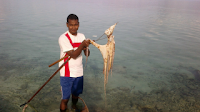Classifying marine organisms
Classification
is an important tool used by scientists to show how organisms are
related to each other and to group them by their characteristics, but
this can be difficult for some marine organisms!
What does classification involve?
Classification involves grouping organisms into a
series of hierarchical categories:
kingdom,
phylum,
class,
order,
family,
genus and
species. These categories were first developed by Carl Linnaeus in the 18
th century and have remained in common use ever since.
However, there is significant debate amongst scientists about
the groupings of organisms within these categories. For example, when
Linnaeus first described his system, he named only 2 kingdoms – animals
and plants. Today, most scientists recognise at least 5 kingdoms, some
argue that there are at least 10 and others debate the value of a
further category, called a domain, that would sit above kingdom.
6 kingdoms of marine organisms
All
kingdoms are represented in the marine environment, and most scientists
classify marine organisms into one of the following 6 kingdoms.
- Bacteria are
single-celled organisms that reproduce by splitting in two. Bacteria
live throughout the marine environment. They play a crucial role in
ecosystems, breaking down organic material and making nutrients
available for the phytoplankton.
- Protozoans are single-celled organisms that are generally much larger than bacteria. They may be autotrophic or heterotrophic. In the marine environment, this kingdom is well represented and includes amoebae.
- Chromists range from very small organisms such as diatoms (a type of phytoplankton) to seaweeds. Most chromists photosynthesise
but there are some significant differences that have led scientists to
classify them separately to plants, for example, they use a different
kind of chlorophyll.
- Fungi rely
on breaking down organic material as they are not able to make their
own food. There are very few fungi in the marine environment.
- Plants are multi-cellular and autotrophic – they use photosynthesis
to produce food using sunlight. Plants are much more widespread on land
and in freshwater, and there are only a few types that thrive in the
marine environment, for example, eel grass and mangroves. Seaweeds were
previously classed as plants before they were reclassified as chromists.
- Animals are typically large and multi-cellular. They are
heterotrophic and rely on other organisms for food. Animals in the
marine environment include jellyfish, sponges, sea spiders, bryozoans,
mussels, sea stars, fish and whales.
- Nature of Science
- Scientific
knowledge may change with the discovery of new techniques and new
information. Scientists commonly debate new information to arrive at new
understandings. For example, recent developments in DNA technologies have resulted in the reclassification of some species.
Animal characteristics
Animals can be broadly divided into
invertebrates (such as crabs and sea stars) and
vertebrates (such as fish and dolphins). Key characteristics of animals include the following:
- They need to obtain energy by consuming other organisms (heterotrophic): Marine animals have evolved a huge variety of adaptations to help them find food. For example, a sea star can extend its stomach
outside its body to digest its prey, such as mussels. Cockles have
siphon like structures that they use to filter organic material and
phytoplankton suspended in the water. Bryozoans band together into
colonies to make it easier to capture food as it floats past.
- They are able to move: This applies to almost all animals
although there are a couple of examples in the marine environment where
this might be more difficult to spot! For example, a number of marine
animals only move about in their larval stage. As adults, they may be permanently attached to a surface, for example, barnacles.
- Their bodies are made up of multiple cells: In
almost all animals, their cells are arranged into tissues that perform
different functions. This sets them apart from other organisms such as
bacteria that are made up of a single cell.
- Sexual reproduction:
Almost all animals reproduce sexually, when a sperm and an egg combine
to produce a juvenile animal. Some animals, such as sea stars, are also
able to reproduce asexually and can reproduce by splitting themselves in
half.
Plant or animal?
With some marine organisms, it can be difficult to tell
what kingdom they belong to. For example, a colony of bryozoans can
often look a lot like a plant. However, look very closely, and you will
see that they are actually made of hundreds of tiny individual animals
called zooids. These zooids look like tiny worms with a nose that has
tentacles around the outside.


Comments
Post a Comment